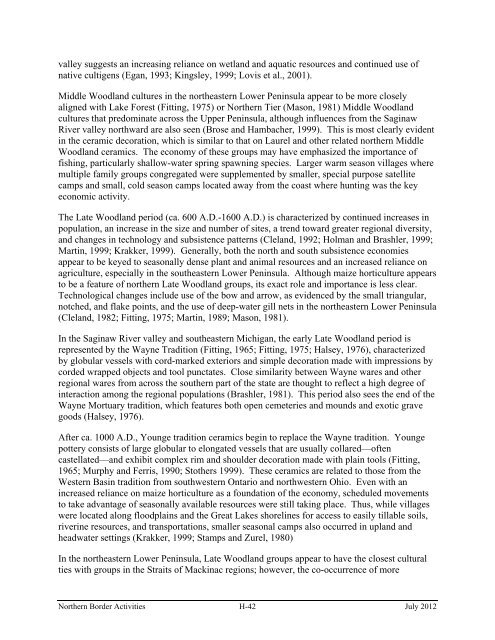Appendix H - Historical Archaeological and ... - CBP.gov
Appendix H - Historical Archaeological and ... - CBP.gov
Appendix H - Historical Archaeological and ... - CBP.gov
Create successful ePaper yourself
Turn your PDF publications into a flip-book with our unique Google optimized e-Paper software.
valley suggests an increasing reliance on wetl<strong>and</strong> <strong>and</strong> aquatic resources <strong>and</strong> continued use of<br />
native cultigens (Egan, 1993; Kingsley, 1999; Lovis et al., 2001).<br />
Middle Woodl<strong>and</strong> cultures in the northeastern Lower Peninsula appear to be more closely<br />
aligned with Lake Forest (Fitting, 1975) or Northern Tier (Mason, 1981) Middle Woodl<strong>and</strong><br />
cultures that predominate across the Upper Peninsula, although influences from the Saginaw<br />
River valley northward are also seen (Brose <strong>and</strong> Hambacher, 1999). This is most clearly evident<br />
in the ceramic decoration, which is similar to that on Laurel <strong>and</strong> other related northern Middle<br />
Woodl<strong>and</strong> ceramics. The economy of these groups may have emphasized the importance of<br />
fishing, particularly shallow-water spring spawning species. Larger warm season villages where<br />
multiple family groups congregated were supplemented by smaller, special purpose satellite<br />
camps <strong>and</strong> small, cold season camps located away from the coast where hunting was the key<br />
economic activity.<br />
The Late Woodl<strong>and</strong> period (ca. 600 A.D.-1600 A.D.) is characterized by continued increases in<br />
population, an increase in the size <strong>and</strong> number of sites, a trend toward greater regional diversity,<br />
<strong>and</strong> changes in technology <strong>and</strong> subsistence patterns (Clel<strong>and</strong>, 1992; Holman <strong>and</strong> Brashler, 1999;<br />
Martin, 1999; Krakker, 1999). Generally, both the north <strong>and</strong> south subsistence economies<br />
appear to be keyed to seasonally dense plant <strong>and</strong> animal resources <strong>and</strong> an increased reliance on<br />
agriculture, especially in the southeastern Lower Peninsula. Although maize horticulture appears<br />
to be a feature of northern Late Woodl<strong>and</strong> groups, its exact role <strong>and</strong> importance is less clear.<br />
Technological changes include use of the bow <strong>and</strong> arrow, as evidenced by the small triangular,<br />
notched, <strong>and</strong> flake points, <strong>and</strong> the use of deep-water gill nets in the northeastern Lower Peninsula<br />
(Clel<strong>and</strong>, 1982; Fitting, 1975; Martin, 1989; Mason, 1981).<br />
In the Saginaw River valley <strong>and</strong> southeastern Michigan, the early Late Woodl<strong>and</strong> period is<br />
represented by the Wayne Tradition (Fitting, 1965; Fitting, 1975; Halsey, 1976), characterized<br />
by globular vessels with cord-marked exteriors <strong>and</strong> simple decoration made with impressions by<br />
corded wrapped objects <strong>and</strong> tool punctates. Close similarity between Wayne wares <strong>and</strong> other<br />
regional wares from across the southern part of the state are thought to reflect a high degree of<br />
interaction among the regional populations (Brashler, 1981). This period also sees the end of the<br />
Wayne Mortuary tradition, which features both open cemeteries <strong>and</strong> mounds <strong>and</strong> exotic grave<br />
goods (Halsey, 1976).<br />
After ca. 1000 A.D., Younge tradition ceramics begin to replace the Wayne tradition. Younge<br />
pottery consists of large globular to elongated vessels that are usually collared—often<br />
castellated—<strong>and</strong> exhibit complex rim <strong>and</strong> shoulder decoration made with plain tools (Fitting,<br />
1965; Murphy <strong>and</strong> Ferris, 1990; Stothers 1999). These ceramics are related to those from the<br />
Western Basin tradition from southwestern Ontario <strong>and</strong> northwestern Ohio. Even with an<br />
increased reliance on maize horticulture as a foundation of the economy, scheduled movements<br />
to take advantage of seasonally available resources were still taking place. Thus, while villages<br />
were located along floodplains <strong>and</strong> the Great Lakes shorelines for access to easily tillable soils,<br />
riverine resources, <strong>and</strong> transportations, smaller seasonal camps also occurred in upl<strong>and</strong> <strong>and</strong><br />
headwater settings (Krakker, 1999; Stamps <strong>and</strong> Zurel, 1980)<br />
In the northeastern Lower Peninsula, Late Woodl<strong>and</strong> groups appear to have the closest cultural<br />
ties with groups in the Straits of Mackinac regions; however, the co-occurrence of more<br />
Northern Border Activities H-42 July 2012
















